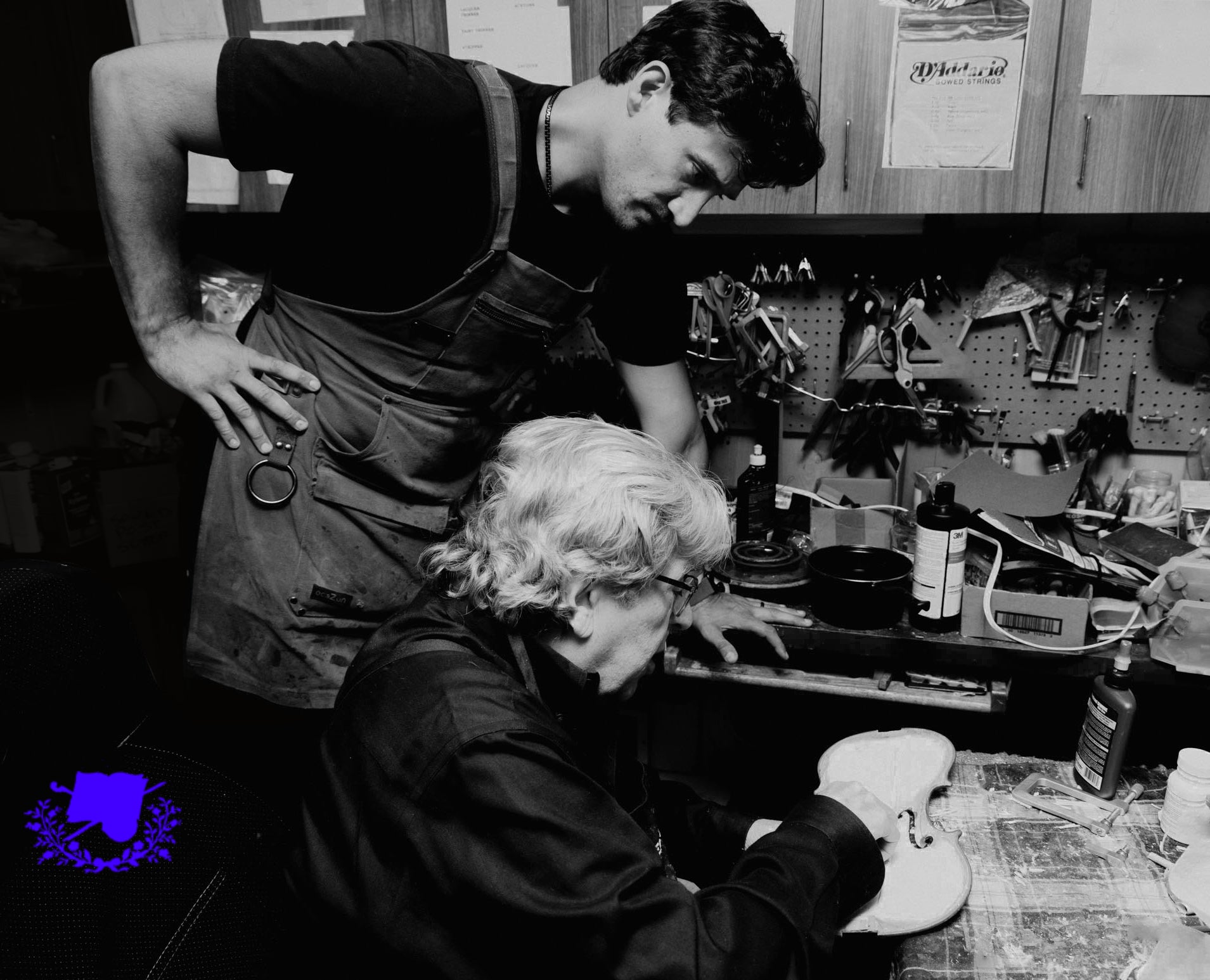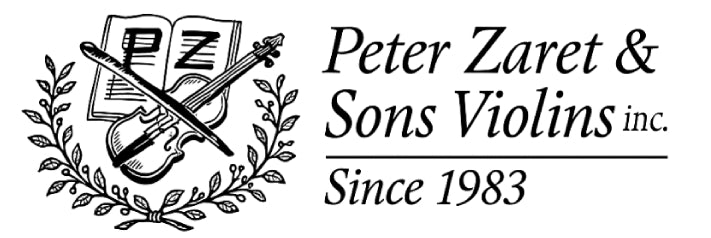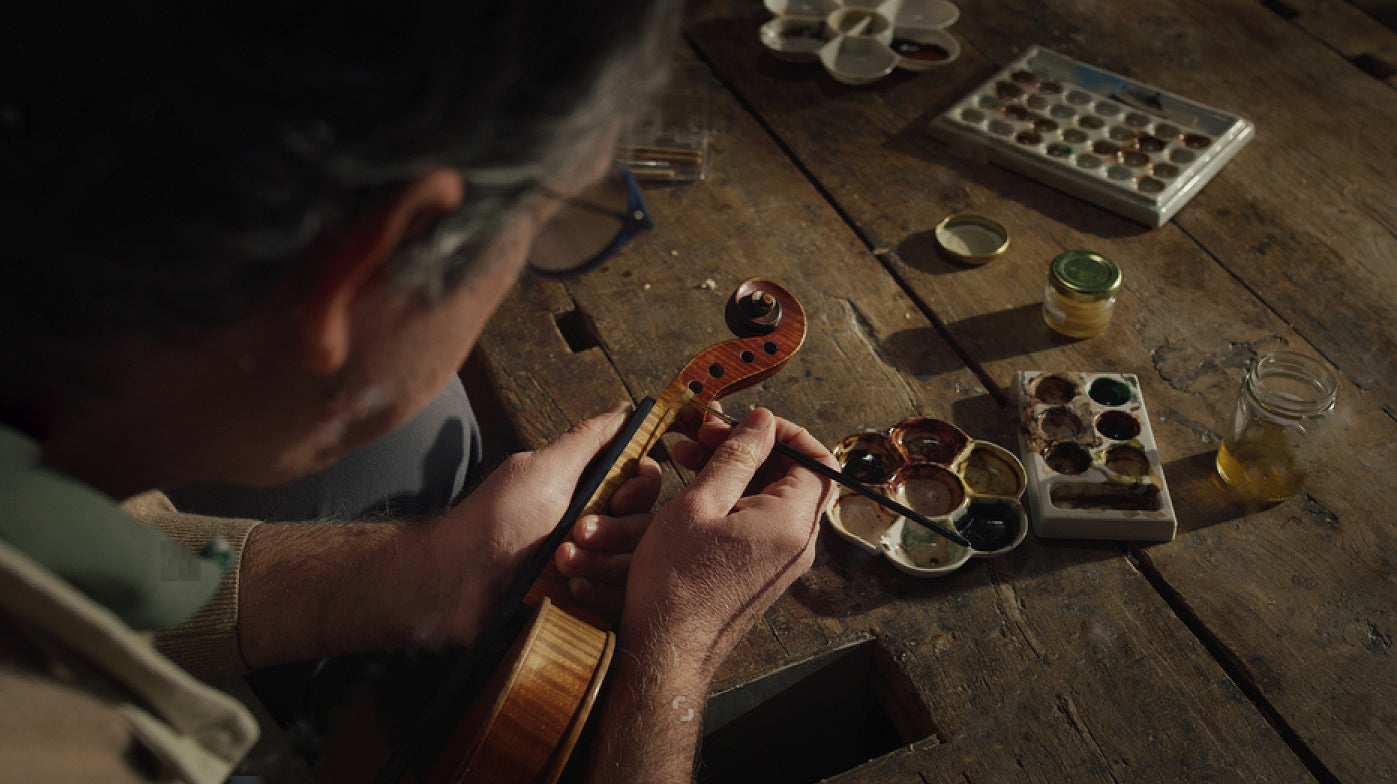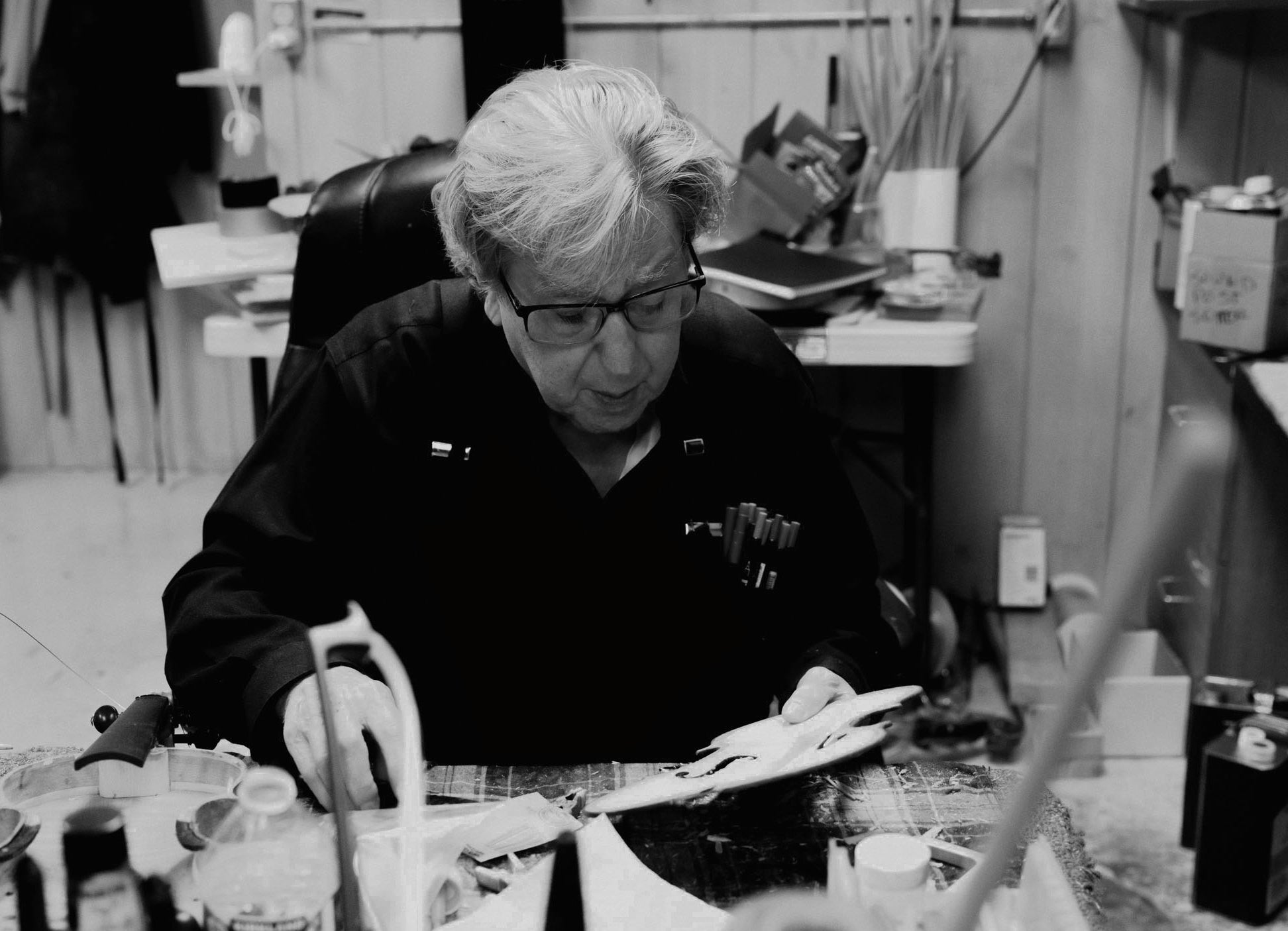
Heredity, Humanism and Violin Making
Among the varied wonders of hyperconnected tele-society, none has proven so enigmatic as the controversial social media post. So vexing was my recent experience of this kind that my reaction was nothing less than the following brief history and philosophy of violin making.
My little naive post to a popular cello building forum consisted of images of a Czech-made cello with Dr. Peter Zaret’s novel sound bar affixed to the inside back plate. It was this seven inch bar of wood, a structural innovation intended to extend the vibratory profile of the instrument body, that incited a kind of moral panic and frenzied outrage among forum commentators. Reactions were visceral and swift, demonstrating an instinctive repugnance at this perceived intellectual pestilence. This throng of indignant protesters hoisted their placards to high heaven with grievances painted blood-red: Shame! Fool! Invasive blemish! Unholy violation of the venerable principles of violin making!
Indeed a startling episode – universal, univocal condemnation in a miraculously coordinated dithyramb of identical thought. Now, noticing patterns and gravitational forces acting on diverse phenomena and grounding the spectacle in an original cause – asking the “What’s goin’ on behind the scenes here?” – this is the exalted calling of homo metaphysicus. I will therefore answer the call with an exposition of the prevailing metaphysical convictions and allegiances of our luthier forum insurgents. We’ll accelerate this veritable principle of sufficient reason to its most radical implication, ultimately expanding a thoroughgoing cosmology. I will then recite an inverse origin myth by evoking the requisite and indefeasible speculative correlates of the first thesis. You, reader, may decide which is more compelling, beautiful, and true.
Lofty ambitions! Yes, undoubtedly - however, controversies that marshal our most cherished intellectual convictions and aesthetic sentiments deserve an analytical treatment of considerable verve and rigor.
The first creation myth of the violin: Re-Production
The first cosmogony of the fiddle is a philosophical expansion of sentiments gleaned from speech patterns, recurring references to pivotal and apocryphal events in the history of violin making, and citations of current research on the topic of violin quality made by luthiers and players alike.
“A violin maker today legitimately pursues excellence in craftsmanship only insofar as he is exceedingly loyal in reproducing the great violins of the first masters.”
In the beginning was Andrea Amati. He created the violin in its substantial modern form in 1560. Subsequent generations of Amatis were responsible for the seminal improvements on Andrea’s foundational work. First son Antonio Girolamo perfected the shape of the f-holes, and grandson Nicolo Amati produced instruments capable of yielding greater power of tone. Nicolo’s son Girolamo II would subtly modify the arching and increase the edge fluting of his father’s instruments. Every subsequent celebrated name in violin making inherited the basic dimensional patterns and technical principles of their profession from these early Amati masterstrokes.
It must be understood, however, that any innovations and improvements to these Amati designs over successive generations were not the result of whimsical trial and error or speculative conjecture about what may or may not theoretically improve sound. The famous workshops did not manufacture, invent, or design instruments – the work of the master was re-produced. This master-apprentice contract was a product of the chivalric psychology of the middle ages; generations of makers dedicated their lives from early adolescence in loyal service to a patriarchal genius. Into the clauses of this binding contract was written the proper ‘science’ of violin making.
We have a fine example of a master of this tutelary science in one of Nicolo Amati’s particularly gifted young apprentices, Antonio Stradivari. During the 1680s, after forty years toiling in Nicolo’s technical crucible, Stradivari began incrementally expanding on certain dimensions of his master’s style, evolving his own soundhole shapes, a softer varnish, and wider purfling. These departures however were merely expansions and adaptations of the substance of an inherited knowledge. This kind of change by ‘genetic mutation’ differs materially from arbitrary scientific speculation and abstraction, issuing as it does from a motion anterior to the static geometry of a mechanized nature. Invention and self-expression were precisely the kinds of hubristic follies masters sought to expiate from workshop culture.
We’ll better grasp the special kind of dynamism motivating violin innovation with an analogy to biological evolution. The violin might be thought of as a kind of anatomical structure in the general biology of 16th century Cremonese tradesmen. The naming conventions for violin anatomy reflect this wisdom: we hold the violin’s body by its neck which is fixed to its ribs; the violin bridge has kidneys, a heart, ankles and feet, etc. If we now ask how the great violins approached perfection in their execution, we can provide the same answer we do to the question of how any organic anatomical structure achieves its startling perfection. From philosopher of biology Henri Bergson, “Instinct finds the appropriate instrument at hand: this instrument, which makes and repairs itself, which presents, like all the works of nature, an infinite complexity of detail combined with a marvelous simplicity of function, does at once, when required, what it is called upon to do, without difficulty and with a perfection that is often wonderful.” The master-apprentice contract preserves this instinctual intelligence as a knowledge revealed and renewed in an enduring act of loyalty to the paternal genius. The word ‘genius’ itself contains inflections of a ‘tutelary or moral spirit’ that ‘guides and governs’; the genius is a ‘generative power’ and a potent ‘inborn nature’. Apprenticeships during Amati’s time assumed just this moral and familial character. The amateur endures exhaustive trials of honor, duty and faith, and by this may hope to earn a seat in the Pantheon of Masters and one day receive into his care his own dutiful progeny.
But these analyses are all historical, culturally contingent, accidental are they not? No – for we are even able demonstrate empirically the epistemological distinction at stake. Let’s focus on the violoncello bridge – all makers today utilize one of a handful of bridge designs for their instruments. Variations do exist – Belgian, French, Baroque – however most contemporary violin builders uses the same design today that was finalized in the 17th century. This standardized cello bridge features idiosyncratic cutouts and irregular shapes which serve to mute a selection of frequencies induced by the vibrating string while amplifying others. This singular structure also must act as a lever to communicate movements to the cello top plate and backplate through the sound post and bass bar. The ornate curls and projections of the bridge impress us as decorative or whimsical in construction, which begs the question why luthiers are irretrievably convinced that this peculiar bridge design is more effective than any imagined alternative. Some geometric or material fact seems to preclude the mind’s access to the precise mechanism of action for each of the eccentric articulations of this little maple structure, a fact which makes both demonstrating and improving its function inconceivable.
This conceptual impasse will only be resolved by undertaking a philosophical investigation into the phenomenology of truth. Λόγος (logos) is the presence of knowledge available to νοῦς (nous), the faculty of the human mind necessary for understanding what is true or real. In the cello bridge, λόγος appears as genetic information latent in the instrument organism itself. Our hubris tempts us to the opinion that the right scientific instruments and analytical methods could rationally explain why the bridge kidney or heart must assume its singular idiosyncratic shape. However, we can demonstrate mathematically why any attempt at representing the truth of these shapes amounts to an insidious falsification and corruption of λόγος.
It was a new ‘science of infinity’ called the infinitesimal calculus, established not long after Amati’s lifetime, that would blot out this hereditary dynamism and logic from intellectual history. Integral and differential calculus was invented by Isaac Newton and Gottfried Wilhelm Leibniz independently of each other in the 17th-century; it became the crown jewel of the new mathematics that underwrote the Scientific Revolution. As rationalist natural philosophers, Newton and Leibniz were disturbed by irregular curves and shapes, trajectories, instantaneous change in motion, and all manner of continuous phenomena, as these ostensibly non-rational ‘problems of infinity’ frustrated existing analytical methods. The imperious intellects of these mathematical reductionists retaliated by confecting the infinitesimal number – the quantity closest to zero without being nothing. They were now in possession of a pseudo-value which could be wielded by the deconstructing mind to calculate the inestimable.
We can now model an irregular shape like the cello bridge heart by simply constructing the heart mathematically using polygons of a known size, and as the quantity of polygons approaches infinity we gain a functional definition of the shape. Did you catch the sleight of hand? We’ve shifted our concern from what exists to what can be infinitely approached. In the same way that a polygon with an infinite number of sides can never become a circle, the bridge heart area is only approached, interpreted or translated by mathematical language; its generative logic, its proper ontological domain remains latent and unrepresented, ensconced as it is in the blind universe of heredity. Indeed this heart-shaped negative space only positively demonstrates what is missing; its present mechanical truth is a secret – a trade secret – invisible to the specious analytical glances of the uninitiated.
Bergson’s notion of a negative reality can further elucidate the dynamic at work here. In studying anatomical structures, he states “A biological organism can only be studied scientifically if the organized body has first been likened to a machine. This is the standpoint of science. For an organic being however, the materiality of the organism does not represent a sum of means employed, but a sum of obstacles avoided: it is a negation rather than a positive reality.” The violin bridge in its organic materiality is not a positive entity but the negation of a wrong bridge. To say that an infinitely many constitutive elements contributed to the positive reality of the bridge is to prove that this structure was not originally assembled from parts at all. If we wish to arrive at a violin’s positive ontological domain we require a wholesale epistemological adjustment that avoids analytical deconstruction.
More fundamental than knowledge by representation, hereditary knowledge holds sway in the binding contract; λόγος is held in being by instinct and fidelity. In violin making this covenant manifests between master and apprentice, father and son. We therefore say that no great violin exists but the violin with a material genetic history traceable to 16th century Cremona, Italy and the patriarch Andrea Amati. A violin maker today legitimately pursues excellence in craftsmanship only insofar as he is exceedingly loyal in reproducing the great violins of the original masters; his solemn mission in all his work should be an indefatigable aspiration to fidelity. Playing around with exotic materials or concocting radically novel structures with zero historical precedent indeed represents a literal abomination of nature, an unforgivable infidelity, and a hubristic folly of the most severe rank.
The second creation myth of the violin: Scientific Invention
The cosmology we’ve just unfolded – the story of a truth sheltered from the crystallization of representation, concealing its wisdom in a lifeforce utterly shielded from measurement, calculation, and objectification – is remarkably powerful. Here we have a totalitarian vision with an infinite capacity to consume and integrate diverse empirical facts and intuitive data, and thereby resolve all speculative thinking into a single notion. But perhaps you feel like something is still missing.
As with all ex nihilo creation myths, there’s a certain pesky itch we can’t seem to scratch. We’re capable of posing a few simple but powerful questions that never seem to have terribly satisfying answers. First there’s the issue of timing: Why did the first sonically and aesthetically exquisite violins emerge in 16th century Italy? The hand-bowed musical instrument existed in some form all over the European continent and Middle East centuries or perhaps millennia before Amati. What miraculous confluence of environmental and intellectual conditions produced The Lady Blunt, King Joseph Guarnerius del Gesu, ex-Huberman, and ex-Vieuxtemps? We’re also aware of the prejudices associated with the accidents of birth; could not the exigencies of reproductive biology delude us with a simulacrum of λόγος, felt intimately as an ‘infinite instinctual truth’ precisely because of our inexhaustible capacity for ignorance?
Our second cosmogony of the violin, like the first, will reveal a powerful explanatory universe capable of consuming every empirical fact and intuition about the essence of reason and metabolizing it for its glorification.
“Today’s musical tool maker should derive his horizon of possibilities from the future articulated by progressive technology.”
A basic reflection on the standard canonized history of Europe shows that Andea Amati lived at the inflexion point of an incipient humanist renaissance. Certainly, however, placing a man’s name into a generalized historical era doesn’t bring us any closer to understanding the gods of his thought. But by training our focus on the word ‘renaissance’ itself, we will reveal something genuinely useful about the inner life of artists and craftsmen in Amati’s time.
The term was first coined in the Italian as rinascita (“rebirth”). It first appeared in Giorgio Vasari’s ‘Lives of the Artists’, written at the height of Amati’s prodigious output in 1550. We’ve come to expect the term renaissance to reliably capture an explosive deconstruction and exhaustive rejuvenation of first principles of thought. A closer scrutiny of the word, however, finds it vexingly deficient in this capacity. Indeed why would a ‘second birth’ produce radically different results compared to the first birth? We are interested in a specific kind of second birth, one differing in crucial ways from the first. Our subject matter does not call for a ‘starting over’; we need a word that implicates regenesis with a vastly different outcome.
Let’s check in on common sense momentarily. To be reborn while expecting a radically different outcome…that would seem to require one simple change of conditions: new parents! So, let’s interpret the renaissance of Amati’s time as a re-parenting. Who were these new progenitors of late-medieval Italians? We’ll call them by their latin names Humanitas and Pecunia. Humanism and Money always mutually imply one another, and indeed the incandescent progeny of their marriage in 16th-century Cremona will furnish us with a powerful refutation of the violin as ‘organic biology’.
We cannot understand any significant era of Italian history without grounding the analysis in ancient Rome. The ideological origin of the social and intellectual pressures that enveloped Andrea Amati comes from Francesco Petrarca (1304-1374) who personally discovered collections of Roman intellectual history not previously known to have existed. The recovery of these texts reanimated the knowledge of the pre-Christian Roman poets, politicians and philosophers. Disdaining what he believed to be the ignorance of the centuries preceding his own era, Petrarch is credited with creating the concept of an historical Dark Ages. But it was Petrarch himself that cast this dismal shadow over Europe’s stagnating cultural inheritance by reaching back over his contemporaries and scouring the halcyon Roman city streets to reunite a faltering mankind with Cicero, Virgil, and Seneca. He found the spiritual fathers of modern European man reposed in white tunics orating in Latin and Greek, jousting with rhetoric at senate, founding the modern schools of philosophy, and generally subjecting every institution to a trenchant skepticism.
If Renaissance man was transfixed by the dazzling arc of his new thought, it was the elevated vantage point of Petrarch’s Rome that sent humanist thinking on its staggering trajectory. However, while aspirations to greatness come cheap, Amati produced prodigiously. And we’re told Andrea used the finest woods from all over Europe, selecting only elite-grade building materials to produce his works. Hundreds of lavishly ornate instruments exuding first-estate noblesse left the Amati workshop. Given the domestic and economic exigencies of the late-medieval period that preceded Amati, a thriving enterprise of such elevated order lacks plausibility.
Indeed a full ninety percent of this population were rural peasants; pressing matters of survival had first claim on mental and physical energy. With a limited diet and short, harsh lifespan, the average third-estate European had exceedingly little patience for the exuberances of artistic expression. Where did Andrea find the time, money, and freedom to indulge in this proto-tourism and fine wood connoisseurship? We can ask the same question for each of the dazzling achievements of artistic manufacture in this period: Donatello’s David represented an astonishing turning point in the history of sculpture not just for its subject matter and mastery of execution, but for the sheer consumption of bronze in its construction. Producing an equivalent impression today would require sculpting the triumphant boy from solid platinum or gold.
We can be forgiven for this gap in our historical sense: Europe’s Commercial Revolution is the decidedly less sexy correlate to the Renaissance. However, humanism is always generously financed, and it is precisely this proto-capitalism that will cash in on the invention of the Human and round out our analysis.
It was England, Spain and Italy’s voyages of exploration that stimulated the emergence of a mercantilist class, giving craftsmen and business leaders a new irrepressible voice in governance. Inherited titles and familial sources of power and influence were subtly and incrementally undermined. This democratic political expansion was accompanied by a liberalization of economic policies that forged Venice, Florence and Milan into vibrant international trading powerhouses, bringing exorbitant wealth to the cities and their inhabitants. It was in this context that the first banking systems and institutions were erected in Florence by the patriarch of the Medici dynasty, Giovanni di Bicci de’Medici. Here we witness for the first time consistent capital investment in infrastructural, architectural, and artistic ventures.
Catherine de Medici, queen consort of France and mother to King Charles IX (1519-1589), commissioned 38 examples of the violin family from Andrea Amati. The instruments delivered in fulfillment of the request were marked by an effortless elegance in execution, a stunningly gentle translucent varnish, and the observation of acoustic and geometrical principles of design. Here is the seminal moment in the elevation of the violin from agrarian appliance to exalted jewel of the humanist intellect. Equipped with the emergent principles of order and logic, a license on experimentation and empirical rigor, and the resurrected necessity of beauty borne aloft on the winds of financial inspiration, Amati dazzled Catherine and his contemporaries. His characteristically Italian élan of invention, his fluorescent caprice and indefatigable finesse of execution apotheosized the little wooden fiddle. Here is the Vitruvian Man of musical tool making, a recasting of the body as a dignified and justified presence in itself, not the awkward encumbrance of our earthly station.
This Promethean frenzy would glow in the hands of luthiers working well in the 18th and 19th centuries. Indeed, the European mind was so enthralled with scientific optimism that virtually no violin created before 1830, including every Stradivari, Guarneri, or Amati, was deemed mechanically adequate to repertory requirements thereafter. The exalted compositional heroes of the 19th century, transfixed by a Dionysian ecstasy with the power to topple nations, history and time itself, had no patience for weak neck angles, stunted fingerboards, and short plucky bows skirting along animal gut strings, scraping out provincial jigs and courantes.
About those animal intestine strings – from Amati’s lifetime to today, novelties of string construction have inspired conquests in extended playing technique, composition and instrument design. It was the emergent global fellowship of luthiers and nascent inter-national tourism that fostered exposure to radically different thinking on string design. While animal intestine strings were tolerated for the upper registers into the 20th century, the excessively thick gut bass strings had deplorable response and anemic tone. For this reason Andrea Amati’s 1566 The King likely had three strings; the known universe of methods and materials prohibited a workable four-string solution. And so Antonio and Hieronymus resolved to rescue their father from this debilitating technical impasse through bold experiment.
These were not the passive servile minds of timid apprentices conceding the wisdom of their master out of an instinctive filial piety. The audacious investigations of the ambitious Amati boys resulted in an expanded variety of instrument configurations with differing string numbers, lengths and compositions. Eventually, with the introduction of woven gut and ultimately metal wound gut strings, a serviceable bass string was provided to the modern violin family.
Jean-Baptiste Vuillaume (1798–1875) however was the first genuine polymathic ubermensch of enlightened violin making. Businessman, inventor and theorist, his workshop at 46 Rue Croix des Petits-Champs pumped out over three thousand instruments. Magna pecunia. Vuillaume’s enduring renown is due in large part to his pioneering research in the fields of acoustics and experimental violin and bow making. Together with Félix Savart, a physician, physicist and pioneer of psychoacoustics, he studied the vibrations of historic Italian instruments and performed mathematical analyses that revealed opportunities to vastly improve projection and tonal complexity. Vuillaume developed a technique for drying wood artificially, experimented with a steel bow in an effort to pursue alternatives to fickle pernambuco, and invented an ingenious ‘self-rehairing’ bow. When Vuillaume grafted a longer 130mm neck to Pagannini’s Il Cannone, a critical dimension of the modern violin was born instantly. The new neck was eventually repositioned to create a sharper string angle, making it easier to play in high positions and drastically increasing projection. The long bass bar we know today was created to better support the increased tension of this new configuration and to distribute the newfound energy throughout the body.
We can scarcely imagine the spectacle of this new Vuillaume violin at full tilt, with its long fingerboard and breakneck string projection, set into apoplectic vibration by the dramatic concave Tourte bow. Perhaps the closest modern analog to the thrill of a violin demonstration at Rue Croix des Petits-Champs is today’s Silicon Valley press conference, that high ranking feast day in the religious calendar of digital transhumanism. Virtual Reality contact lenses? A smartphone that rolls up into your pocket? The European public was at once perplexed and captivated by the debut of this new order of power. How did they do this? – it’s the question perpetually renewed by the singular achievements of history’s intrepid luthiers.
Neuralink, Elon Musk’s brain–computer interface (BCI) company, implanted a ‘brain-reading’ device into a person for the first time this month. The Neuralink chip contains 64 flexible polymer threads installed directly into brain tissue, providing 1,024 sites for recording brain activity. BCIs record and decode neuronal behavior, allowing the severely paralyzed to control a computer, robotic arm, wheelchair or other device through thought alone. Today’s musical tool maker must derive his horizon of possibilities from the transfigured world these disruptive technologies articulate. He should ask questions like ‘Can A.I. help us create a better violin? Can 3D printing offer advantages over wood carving? Could lightweight, heat-resistant synthetic fibers or carbon composite solids be better projectors and distributors of string vibrations?’ Inventors and scientists will provide these answers, as they have done since Andrea Amati’s Cremona.
Which story was more convincing to you? Which was more beautiful? More true?
Perhaps there is a duty incumbent upon the amateur philosopher of science and luthier alike to observe our minds and the way our practical judgments secure their ontological footing, and to profess metaphysical allegiance only in deference to the unique challenge of thought and material facing us directly. Through this ἄσκησις, this stoicism and reticence of judgment, we might improve our work, our playing, and our relationship to musical beauty and truth.
When I met Dr. Zaret at his workshop, he took pains to assure me that in all his work he exercises free inquiry synergistically alongside inherited wisdom. We can observe that synergy in his cello bridge, our favorite tiny maple tower. Dr. Zaret’s hand-carved bridge follows ancient design tenets down to the finest chamfer and bevel – with one curious alteration: spruce risers have been exquisitely grafted to the feet. Spruce is a softer wood compared to maple and exhibits different behaviors in response to shear and tensile forces. However, I have no clue personally what the scientific thinking was behind this innovation. What I can say is the Zaret cello is the loudest I’ve ever played, and sounds beautiful.




Leave a comment
This site is protected by hCaptcha and the hCaptcha Privacy Policy and Terms of Service apply.